Fall is a perfect time to grow garlic. But for successful growth and development, using the right type of soil mix is very important. Today, we will discuss garlic’s soil requirements.
Garlic plants want their soil to be consistently moist yet well-drained. The best soil for planting garlic is sandy, loamy soil with lots of organic matter. If you have heavy clayey soil, you must plant garlic on the ridge of the soil. Besides, the ideal pH level of the soil for garlic is 6-7.
However, there are many things to understand about garlic’s soil requirements. If you are a beginner at growing it, this article can help you know its right soil and some recipes.
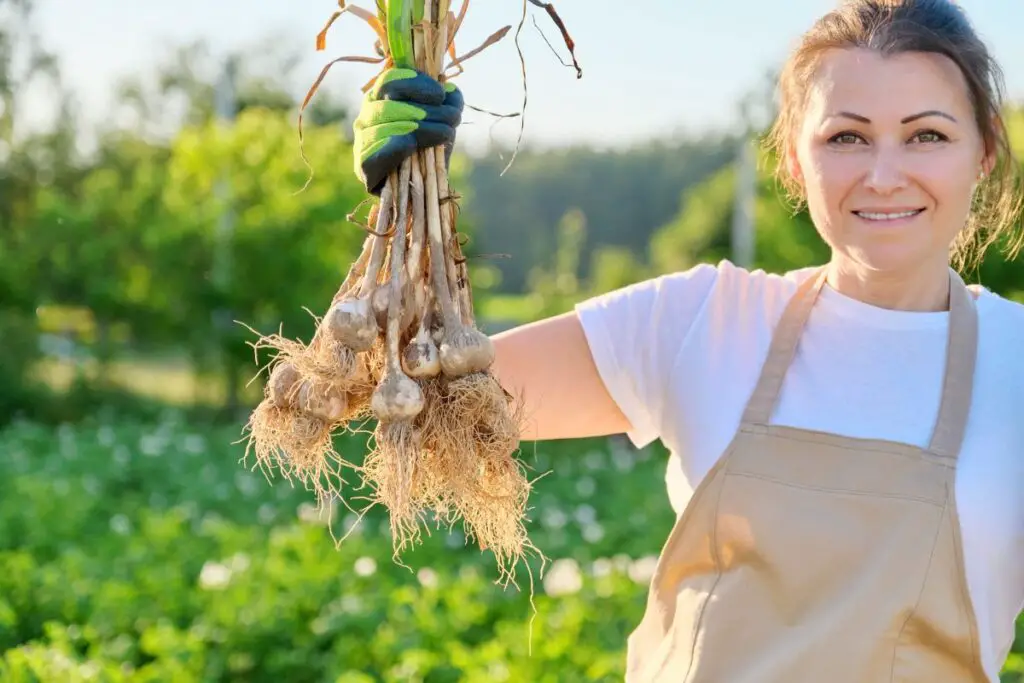
What is the importance of using the right soil?
Using a suitable soil type while growing garlic plants is essential to their life.
Without the correct soil, garlic’s smooth development will get affected.
When growing garlic in your garden, you need to check drainage, retention, penetrability, or pH levels.
If anything doesn’t match, you have to make amendments and adjustments.
The right kind of soil helps the garlic to:
- Have a faster appearance of the heads
- Grow big and healthy bulbs
- Be more flavored
- Develop well overall
Right soil also saves the plant from overwatering, dehydration, and nutrient deficiency.
Signs that you are using the wrong type of soil for garlic
When you use the wrong soil type, the garlic plants show signs like yellow or droopy leaves, soggy soil, or dry soil.
These signs could be symptoms of other issues like overwatering, underwatering, or lack of nutrition.
These signs get displayed despite you following the right routine.
You might be using the wrong type of soil that holds water for a long time or draining faster, the pH is wrong, or it is not fertile enough.
Some visible signs are:
- Soil stays wet for a long time
- Soil dries faster and stays dry for a long time
- You can’t see any development in the plant
- The heads do not appear
- Drooping or premature yellow leaves
- Decayed leaves or roots
When you see these signs, consider checking your soil.
Maybe it’s too clayey or sandy or has the wrong pH levels.
Send your soil for a test or use a pH tester or meter to determine the pH levels.
Factors to consider while choosing the soil for garlic plants
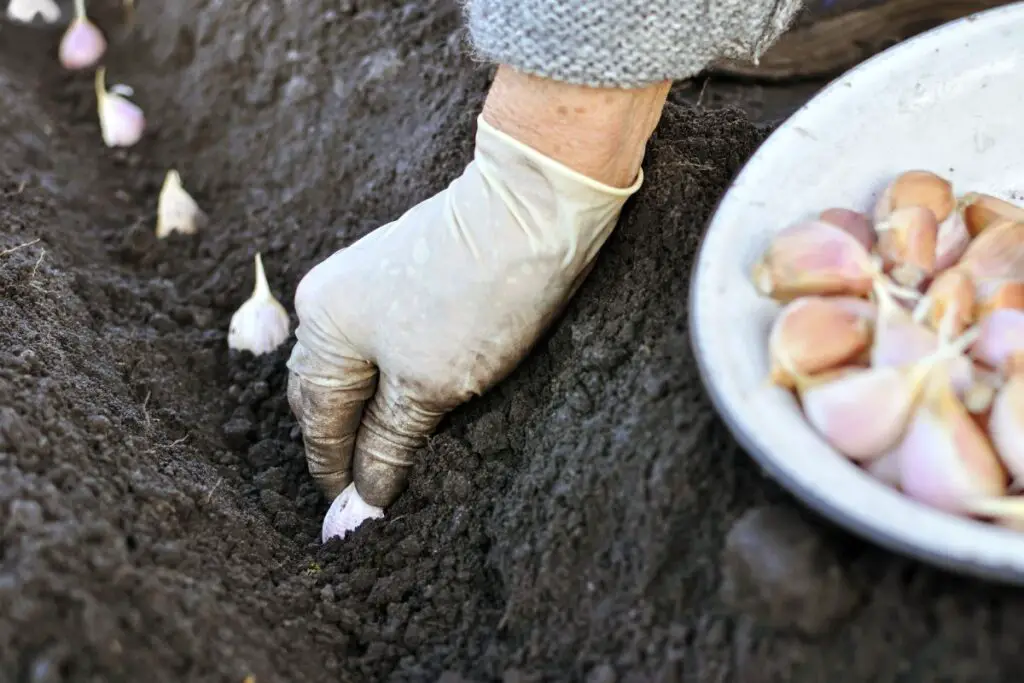
In general, garlic plants can be grown in various soil types.
But, for good and large garlic, you have to make certain adjustments to make the soil type favorable for garlic.
Below are some things you need to consider while planting garlic plants:
Drainage
Whatever soil you use for garlic plants, make sure it has sound drainage.
If the soil doesn’t drain water well, the moisture will stay in the soil for too long.
In such situations, the soil around the roots remains wet for a long time.
It can further result in different rots, like root rot, basal rot, botrytis blight, and white rot.
An ordinary soil can be too clayey, which holds moisture for a long time.
However, you can still grow garlic plants in these soils, provided you control the moisture conditions.
You can grow garlic in raised beds by adding organic matter like peat moss, manure, and compost to the soil.
Even if you use the clay soil in raised beds, your garlic plants will grow well.
Raised beds don’t accumulate water in the soil.
However, it would be best to manage the moisture conditions still.
Retention
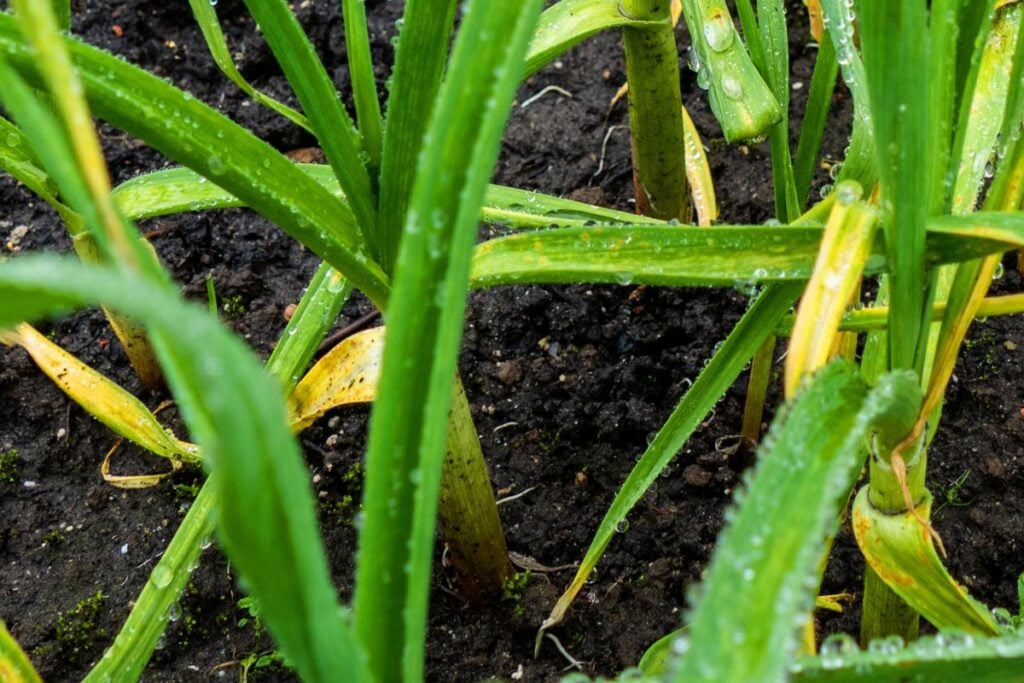
Besides good drainage, the soil must also be good at retaining moisture.
If the soil drains faster than its usual rate, then it won’t be able to hold the moisture and nutrients for long.
As a result, your plant will suffer from dehydration and nutrient deficiency.
Due to dehydration and lack of nutrients, the plant will not develop well, and the bulbs may grow smaller.
Sandy soil is poor in retention.
Using sandy soils and adding organic matter helps increase the retention qualities and adds fertility to the soil.
Garlic will do great in sandy soils as long as they receive adequate moisture and nutrition.
Soil fertility
Garlic needs high-fertile soil to become healthy and produce large and healthy bulbs.
Before planting the garlic plants, consider a soil test to know what nutrients are present or what extra nutrients you should provide to increase the soil fertility.
Sometimes, gardeners add organic matter to make the soil fertile and don’t perform any soil tests.
But, you should still send the soil for testing despite adding the organic matter.
Adding organic matter may make the soil fertile.
Still, some nutrients might be absent, which are very important for garlic plants.
The soil should have a sufficient amount of:
- Potassium: For better leaf and bulb development and prevention of deformed bulbs.
- Sulfur: For flavored garlic and addition of positive health, which makes garlic famous.
- Phosphorus: For root development and encouraging the plant to absorb the water and nutrients.
- Nitrogen in breaks: For overall growth. Add 1/3rd during planting and 2/3rd when the growing season starts in spring.
Soil pH level
Garlic needs soil with a pH level ranging between 6 and 7.
Improper pH levels can result in basal rot.
So, before you plant the garlic cloves or seeds, check your soil’s pH level.
Either send it for a test, or you can do it yourself with a tester.
The soil should be neither too acidic nor too alkaline.
To correct the pH level:
- Use lime to increase pH or peat moss and sulfur to decrease the pH.
- After some days or weeks, test the soil again.
- If it shows the right pH, prepare to plant garlic.
Water permeability
Before you plant garlic, you need to know how deep the water will go.
Since garlic roots can reach about one foot in length, water has to reach that deep.
Dig a small shallow well in the planting site, fill some water 2-3 times, and let it drain.
Again, dig the soil to see how far the water has reached.
If it has gone 1 foot deep, that’s the right place for garlic.
Looking for gardening supplies? We have tested 100's of products before recommending them to you guys. Check out our best pick below:
| Image | Gardening Supplies | Best Price? |
|---|---|---|
 Top
Top Top
Top | Raised Garden Bed Kit | Check On Amazon |
 | XLUX Soil Moisture Meter, Plant Water Monitor, Soil Hygrometer Sensor for Gardening, Farming, Indoor and Outdoor Plants, No Batteries Required | No Results |
 Top
Top Top
Top | 82 Pcs Garden Tools Set and Extra Succulent Tools Set | Check On Amazon |
 | Joeys Garden Expandable Garden Hose with 8 Function Hose Nozzle, Lightweight Anti-Kink Flexible Garden Hoses, Extra Strength Fabric with Double Latex Core, (50 FT, Black) | No Results |
 Top
Top Top
Top | Dual Chamber Compost Tumbler | Check On Amazon |
 Top
Top Top
Top | Sunnyglade Plant Stakes | Check On Amazon |
 Top
Top Top
Top | Organic Cold Pressed Neem Seed Oil | Check On Amazon |
 Top
Top Top
Top | Mighty Mint Gallon :-Insect and Pest Control Peppermint Oil | Check On Amazon |
 Top
Top Top
Top | Scotts DiseaseEx Lawn Fungicide | Check On Amazon |
 Top
Top Top
Top | Jacks Classic 20-20-20 All Purpose Fertilizer | Check On Amazon |
 Top
Top Top
Top | 30,000 Seeds Pollinator Attracting Wildflower Mixture | Check On Amazon |
 Top
Top Top
Top | Survival Vegetable Seeds Garden Kit-Over 16,000 Seeds | Check On Amazon |
Aeration
Air has two components – carbon dioxide, which the plant uses for photosynthesis, and oxygen, used by the roots and stem.
The soil mix you use should be loose and well-aerated, not compact.
A compact soil will not let the roots receive the oxygen and suffocate them.
What is the best soil for garlic plants?
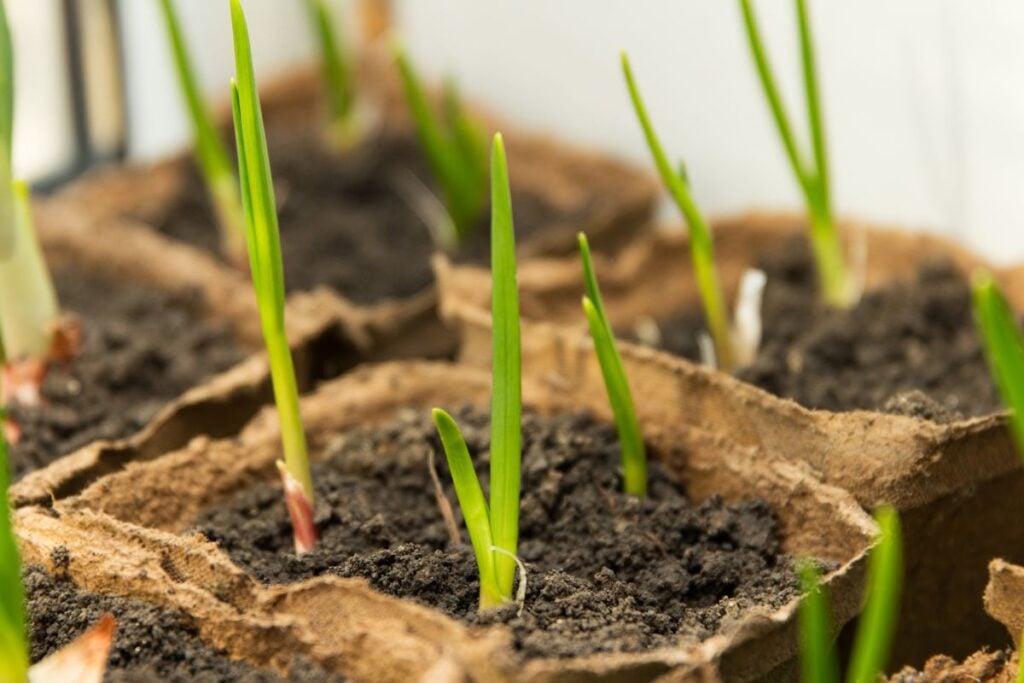
In general, soil that drains and retains well and is rich in nutrients is the best soil for garlic.
Below are some ideal types of soil you can try while growing garlic:
Loam soil
Loam soil is considered perfect for garlic plants because it retains enough moisture.
Your garlic will stay consistently moist without getting wet.
Loam contains equal parts of silt and sand and less amount of clay.
If you ask for an approximate rate, loam contains 40% silt, 40% sand, and 20% clay.
Sandy soil
Sandy soil alone cannot be good for the garlic plants because it drains the moisture and nutrients faster.
But, it is good for sound drainage.
Adding some fertilizer to this kind of soil can help improve garlic’s health and size.
A mixture of sand and loam is sandy loam, and it is profitable for garlic plants.
Organic matter will make the soil nearly perfect for garlic growth.
But remember not to add too much organic matter as that can increase retention too much.
Potting mixes
These are pre-mixed compositions and can be used to enhance garlic growth.
Most potting mixes contain peat moss, coco coir, sand, perlite, vermiculite, and compost.
Each of them has its role.
Together, the ingredients become the perfect soil mix for garlic’s overall growth and development.
Clay soil
It is not preferable for the garlic because clay can hold water.
But, you can use well-drained clay for larger bulbs.
As long as you control the watering, clay soil is fine.
Adding some organic matter can make it better for garlic.
Best soil mixes for garlic plants
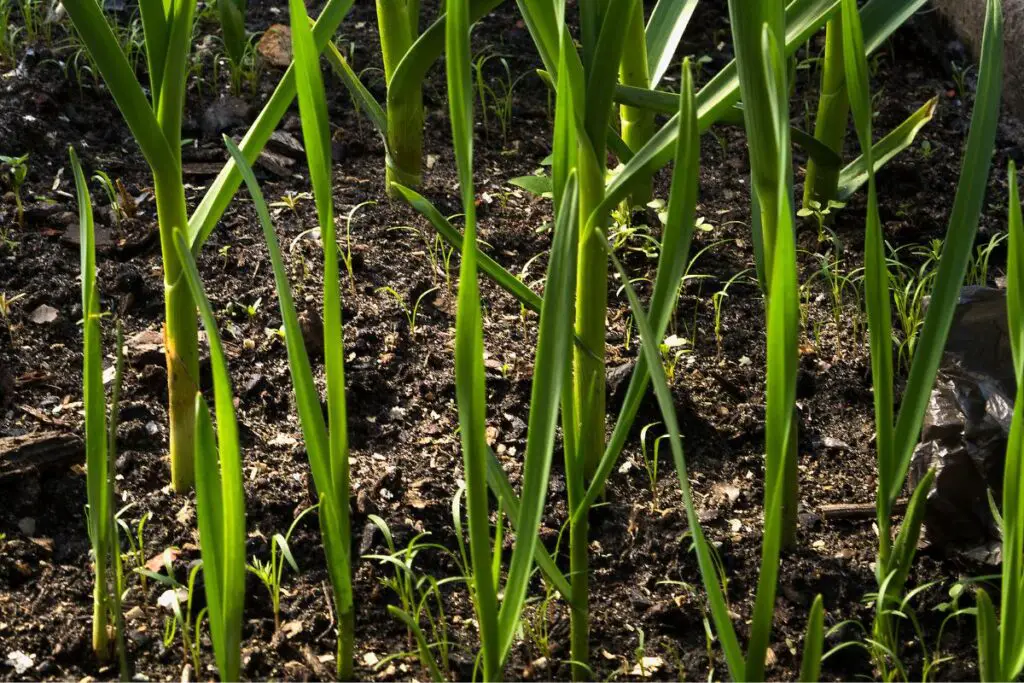
If you grow garlic in the ground, you only need to amend it by adding ingredients that can make the soil correct for garlic.
But, if you use pots or create raised beds, you will require some soil mix recipes that will be good for garlic growth and development.
Below are some recommendations:
Recipe 1
- 60% normal garden soil
- 40% organic matter or compost
Recipe 2
- 6-gallon sphagnum peat moss or coconut coir
- 4½ gallon perlite
- 6-gallon organic compost
- ¼ cup garden lime
- 1½ cup all-purpose organic granular fertilizer
Recipe 3
Create a raised bed with a measurement of your choice and fill it with garden soil.
For amendments, loosen the soil and add:
- A few inches of compost
- A little bit of soil conditioner like alfalfa meal
- One or two handfuls of Neem cake as fertilizer
Recipe 4
A good mix in equal parts of:
- Peat
- Perlite
- Vermiculite
- Potting mix
- Some builder’s sand
Recipe 5
- 3 cups of potting soil
- 1 cup of compost
How should you prepare the soil for planting garlic?
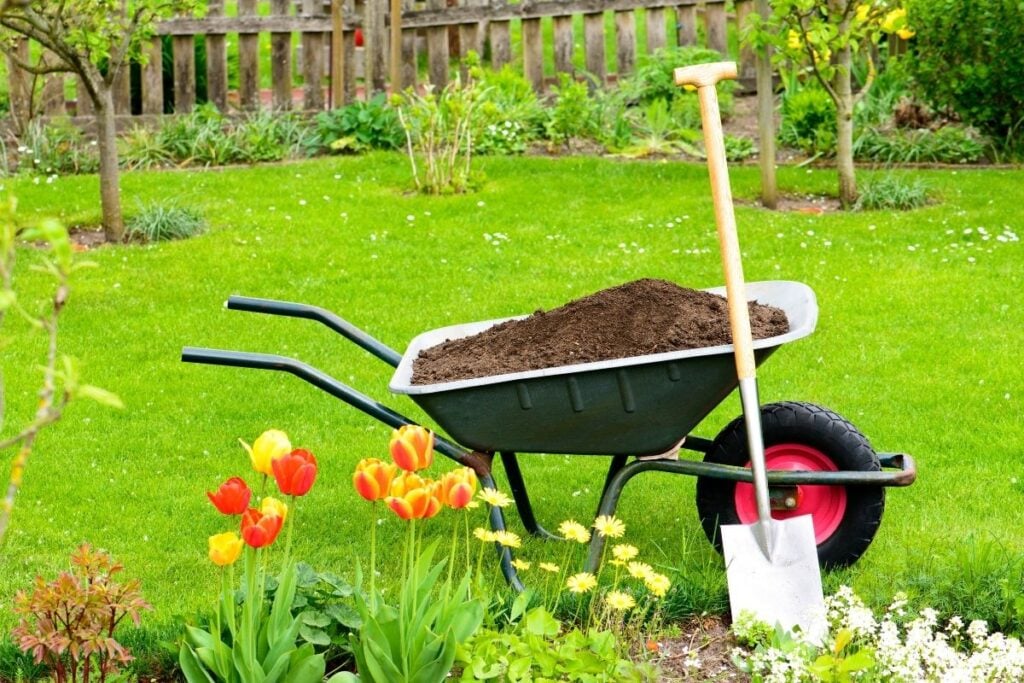
You should prepare the soil for garlic, depending on some situations.
If the soil is perfect in everything, you don’t need much effort to prepare the planting site.
But, if it’s poor, you have to make adjustments.
Preparing the ground for garlic plantation
If you are planting garlic in your garden ground, first ensure that the location receives full sun.
Next, add 1-2 inches of compost over the plantation area and mix them well in the top few inches of the soil.
Also, get the soil tested for pH levels and add some lime or sulfur to adjust the pH levels while preparing the bed.
If you add compost or manure, you don’t have to add any fertilizers until spring.
Before planting, you can consider using herbicides and some tillage to remove the weeds.
Preparing the ground with poor soil for planting garlic
If your garden soil is very clayey, it is not ideal for direct garlic plantation.
The soil is heavy and retains moisture for a long time, which can cause overwatering and root rot.
If you don’t have any other option, you can add compost or manure to improve the soil quality.
You only need to manage the watering techniques.
If the moisture remains controlled, garlic plants will grow over clayey soil without issues.
The addition of compost or manure improves soil fertility and encourages healthy growth.
The best way is to create raised beds.
Even if you use your garden’s clayey soil, the raised beds don’t let the soil hold the moisture for long.
If your soil is too sandy, adding compost and manure will help.
Manure and compost will not only increase fertility but also improve retention qualities.
While adding these components, loosen the soil and add these ingredients very well.
Your soil is now ready for plantation.
Preparing the land with and without tillage
As mentioned earlier, the soil should be well-drained, well-retained, and rich in organic matter.
While preparing the land for garlic, you can consider two ways – with tillage and without tillage.
With tillage
In this method, you have to plow the field 2 times or even more every 7 days or at a few intervals.
You can also use a rotavator installed in the tractors to plow.
Without tillage
It is done when the soil is too wet.
Without any tilling, let the soil dry if it’s too wet until you receive the desired moisture level for garlic.
Build canals around the paddies to prevent the water from standing still after recent rains or irrigation.
How to compost the soil?
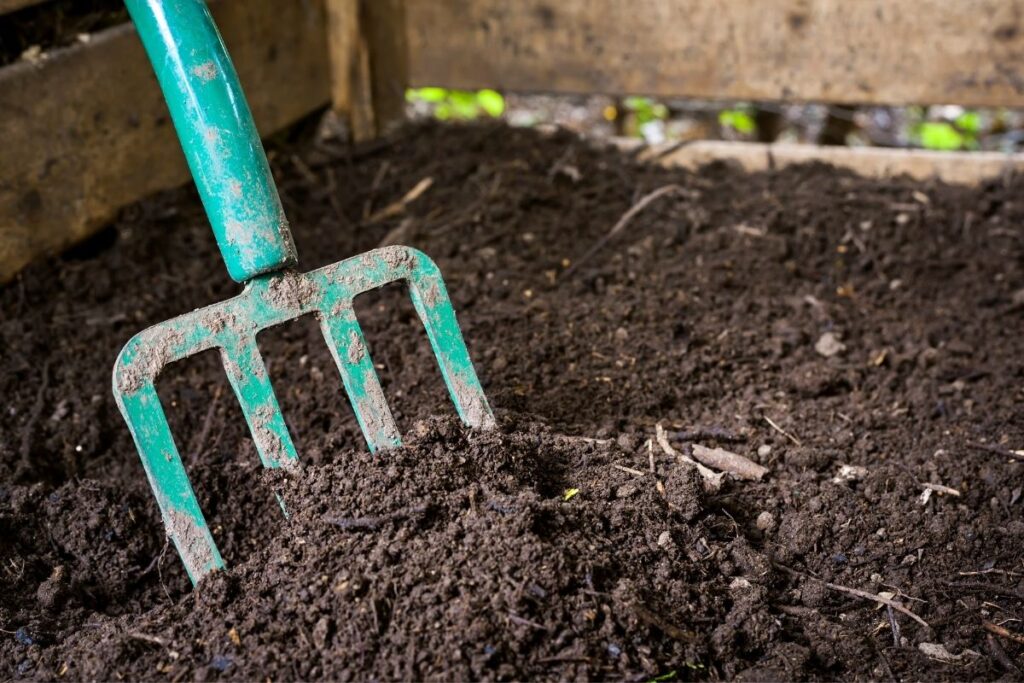
You can use organic matter like a cow or chicken manure to add nitrogen while composting the soil.
Use it 3 weeks before planting.
You also need to add phosphorus for root development, potassium for healthy bulbs, and sulfur for healing and flavor.
Spread some gypsum over the planting bed to add sulfur when new growth appears.
For adding mulch over the soil bed during winter, you can use straws, leaves, wood chips, and grass cuttings.
Remember to avoid mulching the soil beds 120 days before harvesting garlic.
How to plant garlic?
Once you have prepared the plantation site for planting garlic, it is time to prepare for the plantation.
First, you need to know which garlic is ideal for planting in your area.
If you live in the colder zones, try the Hardneck garlic because it is hardy in colder zones.
But, if you are from the warmer zones, grow Softneck garlic.
It is not only native to warmer zones but loves and tolerates more sunlight and warmth than the Hardneck varieties.
- Take some garlic and separate the cloves.
- For bigger bulbs, use the bigger cloves for planting.
- Avoid the damaged and rotten garlic.
- Now, make holes for placing the cloves 4 inches apart.
- Plant them 2 inches deep.
- Face the wide side downwards and the pointed side upwards.
- Water the soil very well. Make sure not to overdo it.
- Let the soil have full sun and reduce the watering gradually when the temperature gets cold.
- If you have used pots, ensure the drainage holes.
Some commercial soil for garlic plants
There are multiple commercial soils available.
You can use these if you don’t have ideal soil in your garden and you don’t have time to prepare and wait.
Before you buy them, you have to look and know some things:
First, consider a soil test with a pH meter or tester.
Second, you need to know the nutrients present in the soil and which one garlic needs.
The nutrients garlic need are:
- Carbon
- Hydrogen
- Oxygen
- Nitrogen
- Potassium
- Phosphorus
- Sulfur
- Magnesium
- Minor nutrients like iron, boron, copper, zinc, chlorine, and manganese
Third, you either get plain soil or soil combined with some fertilizer.
Plain soil can give your garlic plants adequate nutrients and is organic too. You have to fertilize it in time.
On the contrary, a soil mix combined with fertilizer also gives adequate nutrients. Besides, you don’t have to fertilize it for at least 6 months.
Now, let’s go through some commercial soil mixes for garlic.
Espoma Organic Garden Soil
- Enhanced with Myco-tone Mycorrhizae
- Perfect for in-ground plantings
- Fortified with Earthworm Castings
- All Natural & Orga
It has a pH level of 5.5-7.5, is organic, contains fertilizer, and has a reasonable price.
Espoma is a very popular brand for plants’ fertilizer and soil collections. It is enhanced with worm castings and myco-tone, which can help in strong root development.
Though the amount of soil may be smaller, it contains high-quality materials. Besides, it is good for a start-up.
It will give your garlic plants adequate nutrients and feed them for several months.
Miracle-Gro Garden Soil
- Soil blended with aged compost and specifically formulated for raised bed gardens
- Grow up to twice the bounty of vegetables, flowers and herbs (vs. Unfed plants)
- This organic raised bed soil is ready to use, with no mixing required
- Not available in CA
- A 6-inch raised bed, sized 2 x 2, will use 2 bags of Miracle-Gro Performance Organics Raised Bed
Miracle-Gro Garden soil is another popular brand ideal for all vegetables and herbs.
It contains the same pH level as the previous one. It is affordable and comes with a fertilizer mix.
Using this soil will make your garlic grow bigger, and you can expect more harvest the whole year.
Besides these advantages, another good thing is that this soil can control the moisture level, so you cannot overwater your garlic bed.
Sun-Gro Black Gold Natural and Organic Potting Soil Plus fertilizer
- Ideal to use for outdoor and indoor containers such as hanging baskets, window boxes, patio planters, and raised beds
- Perfect growing medium for all your gardening applications such as annuals, perennials, vegetables, herbs, and house plants
- Provides a retention advantage against constant exposure to heat, wind, and sun
This soil can be used as both in-ground and potting soil. It is mixed with fertilizer and available in small and big packages.
The soil is organic, loamy, and perfect for garlic planting.
The soil has a mixture of perlite and pumice, which helps in good drainage and aeration.
It also contains worm castings, peat moss, and other essential nutrients that can make the garlic bigger, more in number, healthier, and better.
Pro-Mix Premium Organic Soil
- Formulated with all natural ingredients
- Contains an organic fertilizer that feeds for up to 3 months
- Suitable for all vegetable and herb garden ne
This soil is ideal for adding or rejuvenating the soil with this organic soil for garlic.
The soil has many nutrients that help boost plant growth, reduce disease and fungal development, and increase garlic growth.
The soil also has sphagnum moss, peat moss, perlite, and organic fertilizers that improve the plant’s health and also feed the plant for at least 3 months.
You can also use this soil for other vegetables, herbs, and flowers.
Compressed Organic Garden Soil
- Easy to use compressed soil granules quickly expand up to 4X and make up to 3 gallons of soil
- Packed with every essential nutrient plus trace minerals, this concentrated super soil feeds your plants for months and makes them grow up to 3 times bigger!
- Easy to wet. Stays moist 3 times longer.
- 100% natural ground coconut coir, worm castings, mycorrhizae, amino acids, and kelp give your soil, plants and garden a super-boost.
- Kid, pet & planet friendly soil, conditioner, and supplement grows more colorful flowers and better tasting nutritious vegetables that are far healthier for y
It has the same pH level as others.
Besides, it is organic and acts faster than others.
It also contains a fertilizer mix, so you don’t have to feed your garlic plants for a few months.
The soil is non-toxic and made with coconut coir, worm castings, amino acids, and useful bacteria.
Altogether, these ingredients will boost the garlic growth.
Additionally, this soil is a granule that can expand 4 times faster and become 3-gallon soil per package.
Another good thing is it stays 3 times wetter than the other types.
So, you don’t need to water them too often. Just check the soil from time to time.
Final thoughts
Garlic plants will grow in any soil as long as their moisture remains under control and fertile and nutrient-rich.
For planting garlic directly on your garden’s ground soil, consider sending it for a test to know about the nutrients and pH level.
You can also create raised beds or grow in pots. Raised beds are a better option as it helps to control moisture.
Reference: The Pennsylvania State University, Garlic Production for the Gardener, University of Massachusetts Amherst, Ohio State University Extension.





